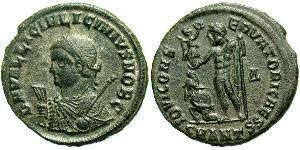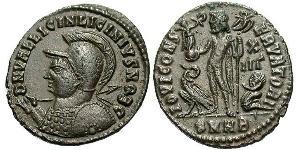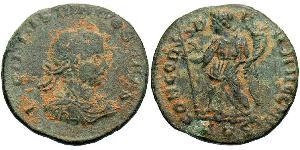Licinius II or Licinius the Younger, full name: Valerius Licinianus Licinius (approx. 315–326), was the son of Roman emperor Licinius. He nominally served as Caesar in the eastern empire from 317 to 324 AD while his father was Augustus. His mother was Licinius' wife Flavia Julia Constantia, who was also the half-sister of Constantine I.
After his defeat by Constantine at the Battle of Chrysopolis, Licinius the elder was initially spared and placed in captivity at Thessalonica. However, within a year Constantine seems to have regretted his leniency and the former Emperor was hanged.
The younger Licinius, who was Constantine's nephew, also fell victim to the emperor's suspicions and was killed, probably in the context of the execution of Crispus in 326.[1]
Other reports relate that Licinius the younger was forced into slavery in the imperial textile factories in Africa, where he is noted in 336. However, the imperial rescript of 336 makes it clear that the "son of Licinianus" referred to was not Licinius II as it directs that he be reduced to the slave status of his birth. No son of Constantine's sister would have been referred to in this manner.[2]
| Political offices | ||
|---|---|---|
| Preceded by Licinius, Crispus |
Consul of the Roman Empire 319 with Constantine I |
Succeeded by Constantine I, Constantine II |
| Preceded by Constantine I, Constantine II |
Consul of the Roman Empire 321 with Licinius, Crispus, Constantine II |
Succeeded by Petronius Probianus , Amnius Anicius Julianus |
References[edit]
| Wikimedia Commons has media related to Licinius II. |
- ^ Grant, Michael (1993). The Emperor Constantine. London. pp. 47–48. ISBN 0-7538-0528-6.
- ^ Pohlsander, Hans A.P. (1996). The Emperor Constantine. New York/London: Routledge. pp. 43–44. ISBN 0-415-13178-2.
- Dietmar Kienast: Römische Kaisertabelle. Grundzüge einer römischen Kaiserchronologie. Wiss. Buchgesellschaft, 3. Auflage, Darmstadt 2004 (unveränderter Nachdruck der 2., durchgesehenen und erw. Auflage 1996), S. 296, ISBN 3-534-18240-5. (German)









